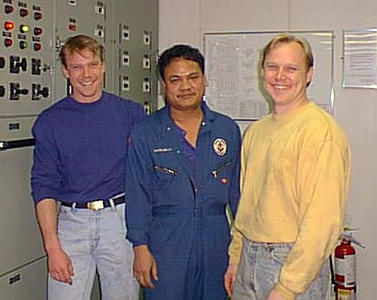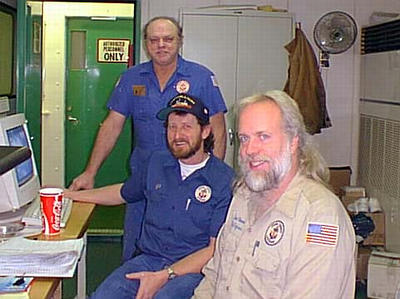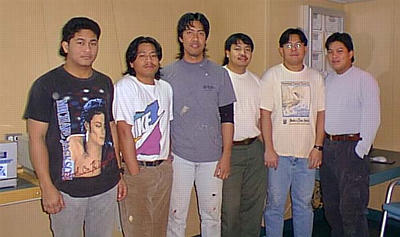
|
|
11 March, 1999
March 11, 1999
Hello from the Amundsen Sea! When I woke up this morning, I found out that
the night shift had some excitement. While they were conducting a
multibeam survery in Pine Island Bay, they found a spot that is nearly 1700
meters below sea level! That's almost a mile deep . . . and to anyone's
knowledge on the ship, it's the deepest point found on any continental
shelf in the world. Everyone is very excited! We have traveled quite a
bit north from the Pine Island Glacier, and we are shooting a seismic line
out of the bay towards the edge of the continental shelf. Tomorrow, we may
take some cores and conduct a deep tow side scan sonar survey of the area
(depending on what we see on the seismic record). After that, we're
heading further east toward Marguerite Bay.
Let's take some time to look at yesterday's question, "What other crew
members do you suppose are necessary to run a ship like the Nathaniel B.
Palmer?" Deck hands are hired by Edison Chouest Offshore. All seven of the
deck hands on the Nathaniel B. Palmer live in the Philippines. Many of
them have been to a Maritime School in the Philippines to learn how to work
on a ship. Some of the deck hands have even earned their Mate's license.
Deck hands do a lot of general purpose work around the ship. Basically,
they work under the direction of the Mates. They help to stand watch on
the bridge -- looking to avoid things like ice or severe weather. They
operate all the winches, move cargo, and help keep up the general
cleanliness and sanitation of the ship. If something has to be painted, a
deck hand will do the work. They also do a lot of the general maintenance
that's required. The deck hands work very hard at a large variety of jobs
both inside and outside the ship. In addition, many of them have added
specialties that come in very handy. For example, one of them is a barber,
one can sew, and another can make beautiful cabinets! Deck hands sign a
contract to work at least 10 months aboard the ship before returning home
for vacation. As people return from vacation, others are able to leave.
Everyone that I talked to likes their job a lot. They really enjoy the
fact that they are working in Antarctica -- where the wildlife is unusual
(penguins, seals, whales) and both the air and the sea are clean!
The rest of the ECO employees on the ship work in the engine room. Johnny
Pierce (J.P.) and David Munroe are the Chief Engineers. At least one of
them is on the Nathaniel B. Palmer at all times. When they are both on
board, such as during our cruise, they share the responsibilities. Their
primary job is to make sure everything on the ship is up and running.
There are 4 main engines, 4 generators, and 2 thrusters that must be
maintained. They are also responsible for the water desalination, sewage
treatment, and trash incineration. In addition, there is a lot of upkeep
on equipment such as spotlights and cranes that they must oversee.
J.P. lives with his wife and 6 year old daughter in Alabama. He graduated
from high school in 1979 and got his first boat job in 1980 as a trainee on
a seismic boat. He had no mechanical experience, so he started off working
on the cable crew. He continued working on seismic boats for various
companies until 1986, when he took a job with Edison Chouest Offshore.
Through years of experience and some serious exams, J.P. has worked his way
up to the position of Chief Engineer. In 1992, he was asked to come aboard
the brand new Nathaniel B. Palmer to work as the Chief Engineer. His
specialty background in air compressors was one of the main reasons that
J.P. was asked to work on the Palmer. Today, he says that he loves to
continue learning new things, and he makes it a goal to learn something new
every day. Even though he misses spending more time at home, J.P. really
likes working on the Palmer and seems especially proud of the teamwork that
is required to run a ship such as this. He enjoys working in Antarctica,
and he loves working with people that he calls the "best of the best."
David was a truck mechanic before he started working as an engineer on
ships. He grew up in Syracuse, New York, but he now lives in Panama City,
Florida. In 1984, a friend helped him get a job working for Edison Chouest
Offshore. He started learning how to work on ships aboard an E.C.O.
research boat in the Gulf of Mexico. With experience and training, he
worked his way up to the position of Chief Engineer. He transferred to the
Palmer when it was ready to be set sail in 1992, and he has been with the
ship ever since. Dave really likes working at sea, and enjoys the fact
that there is always something diferrent to fix or figure out with his job.
Working under J.P. and David are 3 Assistant Engineers (just like the Mates
work under the Captain). Bryan Zipperer has worked on the Palmer since
1992. He is from Florida, but he now lives in Arkansas with his new wife.
Scott and John Kutil are brothers who grew up in Cape Cod, Massachusetts.
Both of them now live in Florida -- with Scott in Ft. Lauderdale and John
in Miami. Scott has been working on the Palmer for about one year. John
joined the ship's crew more recently, and he has only been at sea for about
three months. There is also one "oiler" aboard the Nathaniel B. Palmer.
An oiler is someone who helps the Assistant Engineers. Ogie Pagdanganan is
from the Philippines, and he is the ship's oiler. He's been on the N.B.P.
since 1994, and he helps the Assistant Engineers with whatever is necessary
to keep the ship running. Twice, they have had to fix the vacuum system so
that the toilets functioned properly. Yesterday, they had to work on a
pump that went out in the engine room. They are all constantly busy fixing
different things on the ship.
So now, we've looked at all the crew of the ship (those people hired by
ECO). They include the Captain and the Mates, the Galley Crew, the Deck
Hands, the Engineers, and the Oilers. One thing that all of the crew has
in common is their dedication to their job. All together, there are 22
crew members on board during this cruise. It may vary by a few people each
time, but the average is always near that number. As people leave for
vacation, other crew members come on board the ship to take their place.
When we unload at Punta Arenas in a couple of weeks, some of the crew will
be leaving for their vacation and other crew will just be coming back on
board.
I can't believe another day has gone by so quickly. They say that time
flies when you're having fun, and I believe it! Of course, we're also
losing time -- we've moved our clocks ahead another hour now, so we're only
one hour behind Indiana time. We have seen lots of really neat things
throughout our expedition. For the last few days, we've been in an area
that was first seen and mapped by Operation Highjump in 1946 and 1947.
What was Operation Highjump? We'll look at that (and more) in tomorrow's
journal. Thanks for all the email . . . it's great to hear from you!
Remember, if you don't get a response to your questions within 24 hours,
please send them again. Email sometimes gets lost in cyberspace on its way
to Antarctica.
Kim Giesting
Latitude: 73 degrees 21 minutes South
Longitude: 106 degrees 56 minutes East
Temperature: -1.4 degrees C
Barometer: 949.5 mb
Wind Speed: 19.8 knots
Wind Direction: 137 degrees (from the Southeast)
Sunrise: 5:33
Sunset: 20:11

Scott, Ogie, and John work in the engine room.

Bryan, J.P., and David work in the engine room.

Here is a picture featuring six of the seven deck hands. From left to right, they are: Ruehl, Ric, Lorenzo, Sam, Ben, and Ricky. Lauro was not on shift when I took this picture. His picture will come in a later journal.
Contact the TEA in the field at
.
If you cannot connect through your browser, copy the
TEA's e-mail address in the "To:" line of
your favorite e-mail package.
|
